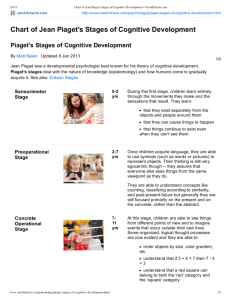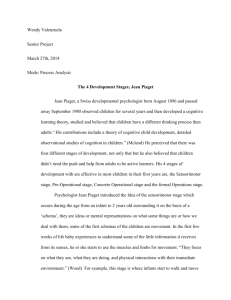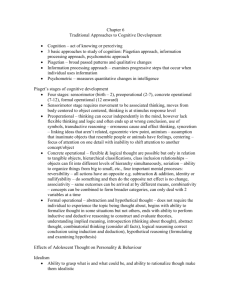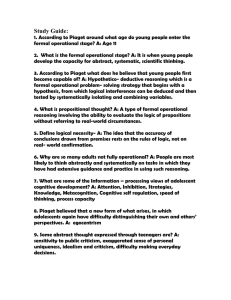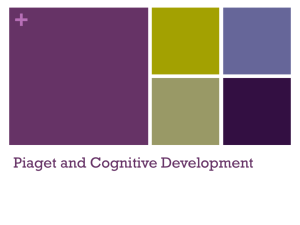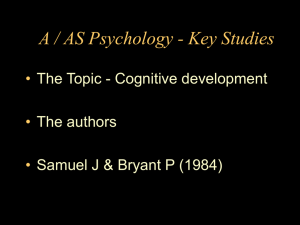Pre-operational Period
advertisement
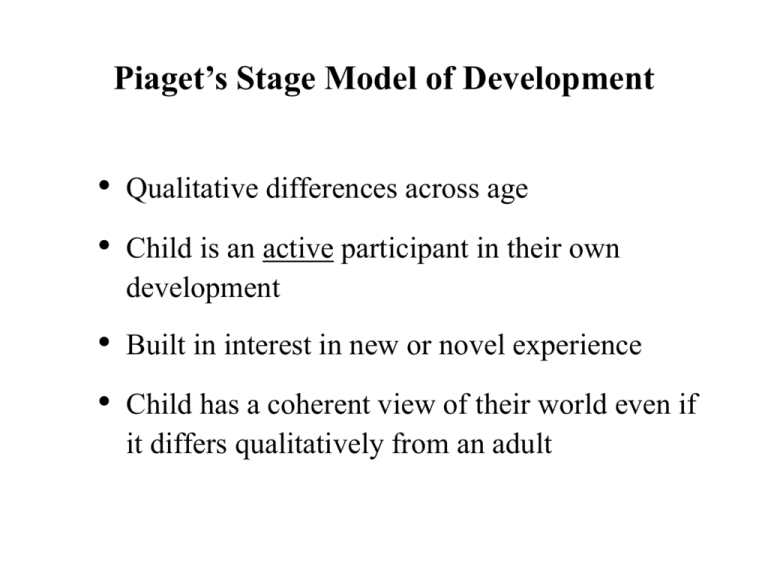
Piaget’s Stage Model of Development • Qualitative differences across age • Child is an active participant in their own development • Built in interest in new or novel experience • Child has a coherent view of their world even if it differs qualitatively from an adult How Does Cognitive Change Occur? • Assimilation – processing incoming information according to existing knowledge and way of thinking • Accommodation – modifying one’s knowledge and way of thinking based on new information or experience • Equilibration – balance between assimilation and accommodation Example of Assimilation & Accommodation A two year old encounters a man who is bald on the top of his head and has long, frizzy hair growing out from each side. The child gleefully shouts “Clown, clown.” Dad tells his child that the man is not a clown, even though his hair is like a clown’s. The man was not wearing a funny costume and wasn’t trying to make people laugh. Child initially assimilates the man to his concept of a clown. After feedback from Dad the child accommodates his idea of “clown” to the concept’s standard meaning. Piaget’s Stage Model of Development • Sensorimotor period (Birth - 2 years) • Preoperational period (2 - 6 years) • Concrete operational period (7 - 11 years) • Formal operational period (11 years onward) Sensori-Motor Period • “Thought is Action” • Understanding of environment built up by manipulating objects • Major Development: Object Concept Sensorimotor Period Modification of reflexes Accidental discoveries Repetitive actions (on own body) Chance actions repeated for effect on environment Understanding of cause & effect; object permanence Active search for new ways to interact with objects Internalized representations Pre-operational Period • • Key development = growth of representational ability Early symbolic representation – Deferred imitation – Problem Solving via Mental Combination Pre-operational Period: Limits on Thought • Child focuses on only one, perceptually striking aspect of a task (centering) • Child focuses on states rather than transformations • Child’s thought is irreversible • Child is egocentric Conservation of liquid quantity Conservation of Solid Substance: Is there more, less, or same amount of clay? Conservation of Liquid Substance: Is there more, less, or same amount of blue liquid? Conservation of Number: Are there more, fewer, or same number of spheres? Pre-operational Period: Egocentric Speech Mary: They wiggle sideways when they kiss. John: (vaguely) What? Mary: My bunny slippers. They are brown and red and sort of yellow and white. John: I have a piece of sugar in red pieces of paper. I’m gonna eat it and maybe its for a horse. Mary: We bought them. My mom did. We couldn’t find the old ones. They were in the trunk. John: Can’t eat the piece of sugar, not unless you take the paper off. Mary: And we found Mother Lamb. Oh, she was in Poughkeepsie in the trunk in the house in the woods. John: Do you like sugar? I do, and so do horses. Pre-operational period: Egocentrism • Three mountain task Understanding Classes & Relations ? Concrete Operational Period • • Key development = mental representations of dynamic and static aspects of the environment Example: Conservation Tasks – substance, liquid & solid – number Concrete Operational Period: Limits on Thought • Child cannot systematically evaluate alternatives • Child cannot reflect on his/her own thought processes • Child cannot engage in hypothetical thinking Classic Problem Jean Piaget: Mixing Colors Problem • 1,2,3,and 4 contain colorless, odorless liquids. • X contains an “activating solution”. • Some combination of liquids (always including X) will give a YELLOW color. • How can you find the combination that makes YELLOW? X Jean Piaget (1896-1980) Children’s Cognitive Development University of Geneva 1 2 3 4 Classic Problem Jean Piaget: Mixing Colors Problem 1+x 1+2+x 2+x 1+3+x 1+2+3+x 1+2+3+4+x 1+2+4+x 3+x 1+4+x 1+3+4+x 4+x 2+3+x 2+3+4+x 2+4+x 3+4+x Jean Piaget (1896-1980) Children’s Cognitive Development University of Geneva Classic Problem Inductive Reasoning: Inferring a Simple Rule • You will be presented a series of geometric figures. • Large or small, square or circle, black or white. • += Conforms to the rule. - = Violates the rule. • What is the rule? Jerome Bruner, Ph.D. A Founder of Cognitive Psychology Harvard University, Center for Cognitive Studies 1960-72 Oxford University 1972-80 New School for Social Research 1980 - What is the Rule? Formal Operational Period • Key development = abstract reasoning emerges • Child is now able to solve problems systematically, considering all alternatives • Child can reflect on his/her own thought processes (metacognition) Formal Operational Period • Abstract reasoning emerges • Can operate on operations (vs. concrete things or events) • Systematic approach to problem-solving • Logical and scientific reasoning

